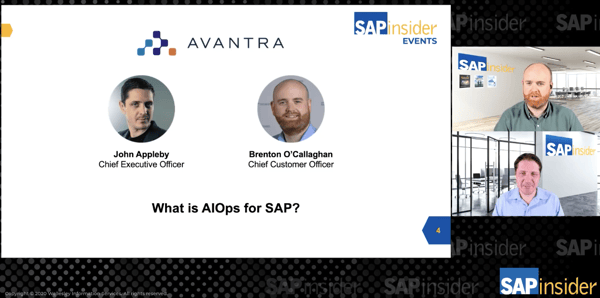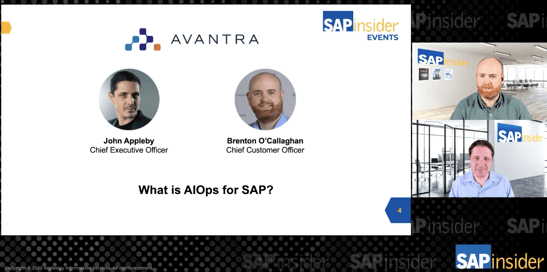6 min read
What is AIOps for SAP? And What Can it Do for You?
By: Marlene Hopewell on Sep 3, 2020 5:59:21 PM

John Appleby, Chief Executive Officer, and Brenton O’Callaghan, Chief Customer Officer, at Avantra recently came together during SAPInsider’s 2020 Virtual Conference to talk about AIOps and how it can help businesses automate their processes.
Read more > https://www.avantra.com/blog/what-is-aiops-for-sap
During the session, they discussed their definition of AIOps, what it means for SAP operations, and what organizations need to consider when choosing an AIOps solution.
Read the highlights of their conversation below.
What is AIOps?
Brenton O’Callaghan: Starting with understanding the terminology, what is your definition of AIOps for the SAP world?
John Appleby: AIOps, in its simplest form, is about using automation to reduce the cost of ownership and to improve the reliability of operations, specifically, SAP operations in the SAP world.
Something that remains to be seen is if a computer can really be intelligent. However, automation has a bigger role than intelligence here. Computers have given us the ability to automate things that humans used to do manually and repetitively earlier.
Take how we built manufacturing equipment over the past hundred years, for example. The advent of automation in manufacturing has made things so much simpler and, it is far more precise than a human. With automation, humans can divert their energy from doing repetitive tasks and commit themselves to innovative tasks by leaving computers to do the monotonous work.
Brenton O’Callaghan: In my opinion, you can define the intelligence part of the AIOps too.
If you intelligently define your automations, you will see an operations landscape that is far beyond what you have currently. It is less about applying AI in the traditional sense but more about applying automation intelligently across operations.
John Appleby: If you do that, you could then have a wealth of data that can provide historic information. We can then look for the same conditions that occurred in the past that will allow us to predict the future.
What does AIOps mean for SAP operations?
Brenton O’Callaghan: Talking about AIOps in a broader sense, how would you apply AIOps principles to SAP operations? Should you start with real-time monitoring and automate daily checks or are there other areas you should be going into?
John Appleby: SAP is a very specific and complex ecosystem. You must think about SAP as an archipelago rather than a generic IT solution.
The example of daily checklists is significant here. Back in the day, I used to log into an SAP system with a checklist that was more than 10 pages long. While some people wrote scripts to simplify their checklists, many organizations still have the old system in place. However, now it is only a matter of how often you would want to check for issues.
Brenton O’Callaghan: Even when the current situation demands that we take up automation, the danger with going down this route is that there could be a lot of ad-hoc automation. Bringing these ad-hoc processes together is then a task which potentially increases the cost of ownership.
John Appleby: I second that. While script-based automation is convenient when compared to manually logging in information every day, ad-hoc processes are hard to get rid of and impossible to manage. Large organizations are more susceptible to this and are unaware of the risks this poses most of the time.

What should organizations consider when choosing an AIOps solution?
Brenton O’Callaghan: With many companies embarking on a digital transformation journey, how will investing in an AIOps platform for SAP help with the long-term strategies of the business?
John Appleby: Investing in AIOps is going to add tremendous value to businesses, and especially those that work with a limited number of people in the SAP ecosystem. Particularly in the US, where companies can no longer outsource work the way they used to, there is immense advantage in making sure that valuable human resource is not being spent on things that can be simply automated by a computer when they can be doing more meaningful work.
Taking the same example of daily checklists again, employees no longer have to spend their time going through a list, checking for anomalies and then spend further time rectifying the anomalies when they can get started on the other priorities planned for the day.
By ensuring that the systems are running properly in the first place, you are moving people away from the routine of daily checklists and the ensuing root cause analysis which takes up a lot of time.
The AIOps system not only monitors what is going on in the environment, it will also raise service requests within the system when a problem becomes apparent, without waiting for users to encounter and flag the issue.
Brenton O’Callaghan: Speaking of time and distractions, what is your advice to organizations who understand the potential benefits of AIOps?
John Appleby: Many IT organizations are setting time aside now to innovate and improve their business. They must commit to a mindset to make a difference, and not do what they have been already doing in an ensuing chaos.
Brenton O’Callaghan: One of my customers told me that every time an issue comes up, they ask themselves if it could have been avoided if they had automated it. If the answer’s yes, they then proceed to automate the issue, so that it does not crop up later. It saves them time and resources to innovate.
Moving on, what is your advice for businesses starting to look for an AIOps solution? What are the criteria that they should focus on and evaluate them on?
John Appleby: Customers should have an exhaustive list of all the features they need.
Start with listing the requirements by focusing on the priorities of the business, from what the future looks like, to where you can reduce the number of people working on repetitive tasks. Ask questions and go into the details to thoroughly recognize your needs. Identify the platforms you need and the databases you want to have supported. Without a good evaluation, customers will not be able to align with their needs in the future.
Furthermore, it is important that you understand the product completely before you buy it, so you are not left disappointed. Spending time to list out the requirements in-depth will save you from later hassles.
Brenton O’Callaghan: To wind up, do you have any final thoughts on the future of AIOps for SAP?
John Appleby: I see a bright and interesting future for AIOps now as the SAP market has not spent enough time on automation over the last 20 years.
Google has also done quite a lot by defining site reliability engineering. Earlier if you had to purchase new equipment to deploy, now there is so much work being done around platforms that you can deploy quickly and at the click of a button.
The time is ripe to take advantage of these benefits and to keep your human capital motivated by using them to keep the business running instead of doing repetitive tasks. In essence, now is a great time for AIOps.
Related Posts
3 Ways to Modernize Your Business Operations
Emily Tippins, Chief Marketing Officer and Brenton O'Callaghan, Chief Customer Officer at Avantra...
What is AIOps for SAP?
What is AIOps for SAP? John Appleby dives into AIOps, how issues are resolved and avoided with an...
How SAP Automation is Saving Companies Money
As more organizations turn to automation and AIOps, Avantra's very own Tyler Constable breaks down...




